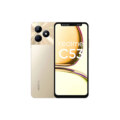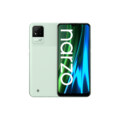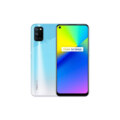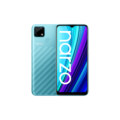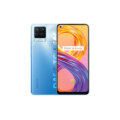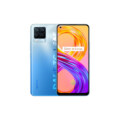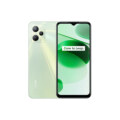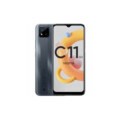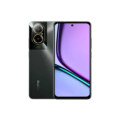Realme C25




Specs
General
| Device Type | Realme Phone |
| Announced | 23 March, 2021 |
| Released | 27 March, 2021 |
| Status | Available |
Design
| Dimensions | 164.5 x 75.9 x 9.6 mm |
| Weight | 209 g |
| Protection | Glass front, Plastic back, Plastic frame |
| Colors | Water Blue, Water Gray |
Display
| Refresh Rate | 60 Hz |
| Display Type Display Technology => A number of display technologies and types used in mobile phones => TFT (Thin Film Transistor), IPS (In-Place Switching), OLED (Organic Light Emitting Diode), AMOLED (Active-Matrix Organic Light-Emitting Diode), Super AMOLED (an even advanced version of AMOLED), Resistive Touchscreen (Resistive touchscreens contain two layer of conductive material with a very small gap between them which acts as a resistance), Capacitive Touchsceen (Capacitive touchscreen technology consists of a layer of glass coated with a transparent conductor) | IPS LCD |
| Size | 6.5 inches |
| Resolution | 720 x 1600 pixels |
| Display Colors Display Colors is refers to the number of different shades of colors that the screen is capable of displaying => 64K colors, 256K colors and 16 million colors, Obviously 16M is highest available range of colors and better than others. | 16M Colors |
| Pixel Density Pixel Density (PPI) is refers to the concentration of pixels on a particular display, measured in pixels per inch (ppi). Pixel density is calculated by dividing the diagonal pixel resolution of a display by its diagonal size, higher pixel density better display quality. | ~ 270 ppi |
| Touch Screen | Capacitive Touchscreen, Multitouch |
| Features | 480 nits (typ) |
| Secondary Display | No |
Camera
| Front Camera | 8 MP, f/2.0, 26mm (wide) |
| Camera Setup | Triple |
| Main Camera Camera is able to capture photographs and usually videos, The most important characteristics of a camera are the resolution (measured in megapixels), lens focus type (fixed or automatic), higher megapixel cameras are known to capture higher quality photos, but not always a good measurement of the photos quality. |
48 MP, f/1.8, 26mm (wide), PDAF (International model) 2 MP, f/2.4, (macro) 2 MP, f/2.4, (depth) |
| Video | 1080p@30fps |
| Camera Features | Geo-tagging, Phase detection, touch focus, Panorama, HDR |
| Flash Flash Light => There is commonly two types of flash lights are used in camera mobile phones, LED Flash (LED flash offers lower power consumption with drive circuitry that takes up very little room, LEDs can be strobed faster than any other light source), Xenon Flash (xenon flash produces an extremely intense full-spectrum white light for a very short duration) | LED flash |
Hardware
| Operating System OS => Every computer system run on a base software called Operating System (OS). Operating System controls all basic operations of the computer (such as smartphone, PDAs, tablet computers and other handheld devices). The Operating System allows the user to install and run third party applications (apps), apps are used to add new functionality to the device. | Android 11 |
| Chipset Chipset is a group of integrated circuits designed to perform one or a more dedicated functions, often with real time computing constraints, Popular smartphones are equipped with more advanced embedded chipsets that can do many different tasks depending on their programming. | Mediatek Helio G70 |
| CPU CPU (Central Processing Unit) mostly known as processors, CPU processes instructions in order to carry out certain functions that make your device operate properly. Processors are often described as the brain of computers, smartphones and tablets, Smartphones and tablets rely on processors to carry out their every task, Processors are an incredibly important factor in selecting any type of computing device, including your smartphone. | Octa-core (2 x 2.0 GHz Cortex-A75 + 6 x 1.7 GHz Cortex-A55) |
| Architecture | 64 bit |
| Fabrication | 12 nm |
| GPU GPU (Graphics Processing Unit) is a single-chip processor designed to rapidly manipulate and alter memory to accelerate the creation of images in a frame buffer intended for output to a display, This includes things such as lighting effects, object transformations, and 3D motion. | Mali-G52 2EEMC2 |
| RAM (Memory) RAM (Random Access Memory) is a type of computer memory that can be accessed randomly, any byte of memory can be accessed without touching the preceding bytes that allows information to be stored and accessed quickly from random locations. RAM is the most common type of memory found in computer systems, smartphones, tablets and other electronic devices. | 4 GB |
| Internal Storage Internal Storage is a data storage space (flash memory) mostly used in smartphones, tablets and other electronic devices where operating system, apps, music, photos, videos, files and other user data Is stored. | 64/128GB Built-in |
| Card Slot Memory Card Slot is a special slot for inserting a memory card. Memory cards allow you to expand the phone's built-in memory, A memory card (sometimes called a flash memory card or a storage card) is a small storage medium used to store data such as text, pictures, audio, and video, for use on small, portable or remote computing devices such as mobile phones, mp3 players, digital cameras. | |
| Sensors Sensors are electronic components that detects and responds to some type of input from the physical environment. The specific input could be light, heat, motion, moisture, pressure and location, The output is generally a signal that is converted to use in computing systems, a location sensor, such as a GPS receiver is able to detect current location of your electronic device. | Accelerometer, Compass, Fingerprint (rear mounted), Proximity |
Network
| SIM TYPE SIM (Subscriber Identity Module) is a small card that contains mobile network subscriber's account information. This allows the phone using the card to attach to a mobile network. The SIM card is most commonly associated with GSM and UMTS mobile networks. Moving a SIM card from one phone to another allows a subscriber to switch mobile phones without having to contact their mobile network carrier. SIM cards can also be used by a phone to store limited amounts of data, such as phone numbers and text messages. | Nano SIM |
| SIM Technology | Dual Sim, Dual Standby (Nano-SIM) |
| 2G Network | GSM 850 / 900 / 1800 / 1900 |
| 3G Network | HSDPA 850 / 900 / 1700(AWS) / 1900 / 2100 |
| 4G Network | LTE band 1(2100), 3(1800), 5(850), 7(2600), 8(900), 34(2000), 38(2600), 39(1900), 40(2300), 41(2500) |
Multimedia
| FM Radio | |
| Stereo Speakers | NO |
| Loudspeaker | YES |
| Audio Jack | 3.5mm Audio Jack |
| Audio Features | 24-bit/192kHz Hi-Res audio |
Connectivity
| Wi-fi Wi-Fi is a popular wireless networking technology using radio waves to provide high-speed network connections that allows devices to communicate without cords or cables, Wi-Fi is increasingly becoming the preferred mode of internet connectivity all over the world. | Wi-Fi 802.11 a/b/g/n/ac, dual-band, Wi-Fi Direct |
| Bluetooth Bluetooth is a wireless communications technology for exchanging data between mobile phones, headsets, computers and other network devices over short distances without wires, Bluetooth technology was primarily designed to support simple wireless networking of personal consumer devices. | v5.0 with A2DP, LE |
| GPS GPS The Global Positioning System is a satellite-based radio navigation system, GPS permits users to determine their position, velocity and the time 24 hours a day, in all weather, anywhere in the world, In order to locate your position, your device or GPS receiver must have a clear view of the sky. | A-GPS support, & GLONASS, BDS |
| USB | USB Type-C 2.0, USB On-The-Go |
| EDGE EDGE (Enhanced Data GSM Environment) is a wireless network technology generally considered the next step in the 2G network offers data transfer rates up to four times faster than ordinary GSM networks, Generally, EDGE is used for the purpose of wireless data transfer, such as sharing pictures and videos or browsing the Internet via a mobile phone connection. | |
| GPRS GPRS (General Packet Radio Service) is a packet oriented mobile data service on the 2G and 3G cellular communication system's global system for mobile communications (GSM), Generally, GPRS is used for the purpose of wireless data transfer, such as sharing pictures and videos or browsing the Internet via a mobile phone connection. | |
| Speed | 3G (HSPA 42.2/11.5 Mbps), 4G LTE-A |
| Wi-fi Hotspot | |
| NFC NFC (Near field communication) is a set of standards for smartphones and similar devices to establish peer-to-peer radio communications with each other by touching them together or bringing them into proximity, usually no more than a few inches. |
Features
| Messaging | SMS(threaded view), MMS, Email, Push Mail, IM |
| Web Browser Web Browser => a web browser is a software application used to locate, retrieve and display content on the World Wide Web, including Web pages, images, video and other files, The primary function of a web browser is to render HTML, the code used to design or markup webpages. | HTML5 |
| Games | Built-in + Downloadable |
| Torch |
Battery
| Battery Type Battery Type => Cell phones run on various kinds of batteries depending on the manufacturer, phone size or shape and features. There are basically four types of cell phone batteries => Lithium Polymer, Lithium Ion, Nickel Metal Hydride and Nickel Cadmium. | Li-Ion (Lithium Ion) |
| Capacity Battery Capacity is a measure (typically in Amp-hr) of the charge stored by the battery, and is determined by the mass of active material contained in the battery. The battery capacity represents the maximum amount of energy that can be extracted from the battery under certain conditions. | 6000 mAh |
| Placement | Non-removable |
| Wireless Charging Wireless Charging (Inductive Charging) uses an electromagnetic field to transfer energy between two objects. This is usually done with a charging station. Energy is sent through an inductive coupling to an electrical device, which can then use that energy to charge batteries or run the device. | No |
| Extra |
Fast charging 18W Reverse charging |
Realme C25 : Detailed Review
Introduction:
The Realme C25, launched in 2021, is an affordable smartphone targeting budget-conscious users while offering solid performance for daily tasks. Known for its long-lasting battery, sturdy design, and decent camera setup, the C25 aims to cater to users who need a reliable phone without splurging on flagship features. In this review, we’ll take a closer look at its design, display, performance, camera system, battery life, software experience, and more.
Specifications at a Glance
- Display: 6.5-inch IPS LCD, HD+ (1600 x 720 pixels)
- Processor: MediaTek Helio G70
- RAM: 4 GB
- Storage Options: 64 GB, 128 GB (expandable via microSD)
- Rear Cameras: Triple 48 MP (wide f/1.8), 2 MP (macro), 2 MP (depth)
- Front Camera: 8 MP (f/2.0)
- Battery: 6,000 mAh with 18W fast charging
- Operating System: Realme UI 2.0 based on Android 11
- Dimensions: 164.5 x 75.9 x 9.6 mm
- Weight: 209 grams
Design and Build Quality
Aesthetics:
The Realme C25 features a simple yet functional design with a plastic back and frame. The matte finish on the back helps resist fingerprints, and the phone comes in two color options: Water Blue and Water Gray. The rear-mounted fingerprint scanner is easily accessible and adds convenience to the overall design.
Durability:
The device feels sturdy in hand, thanks to its thick build and solid plastic construction. Realme has ensured that the C25 comes with TÜV Rheinland certification, which tests its reliability under various conditions, making it more durable for daily use.
Ergonomics:
At 209 grams, the phone is relatively heavy, mainly due to its large 6,000 mAh battery. The phone’s curved edges make it more comfortable to hold, but one-handed use may be challenging for users with smaller hands.
Overall, the Realme C25 offers a functional and durable design that prioritizes practicality over flashy aesthetics, making it a good choice for users who prioritize durability and functionality over sleek design.
Display
Specifications:
- Size: 6.5-inch IPS LCD
- Resolution: 1600 x 720 pixels (HD+)
- Refresh Rate: 60Hz
- Brightness: 480 nits (typical)
Performance:
The 6.5-inch HD+ display offers decent color reproduction and good brightness levels for outdoor use. While the resolution isn’t as sharp as more premium devices, the display performs adequately for browsing, social media, and media consumption. However, the 60Hz refresh rate feels basic compared to modern devices that offer smoother performance with 90Hz or 120Hz screens.
Viewing Experience:
The Realme C25’s display is sufficient for watching videos and casual gaming, but it falls short of delivering a truly immersive experience due to its lower resolution. The viewing angles are decent, and the color accuracy is good for a phone in this price range.
In summary, the display offers a decent experience for the price, though users looking for sharper and smoother visuals may find it lacking.
Performance
Hardware:
- Processor: MediaTek Helio G70
- RAM: 4 GB
Performance Evaluation:
Powered by the MediaTek Helio G70 chipset, the Realme C25 delivers satisfactory performance for daily tasks such as browsing, social media, and casual gaming. The 4 GB of RAM allows for moderate multitasking, though performance may slow down when multiple apps are open simultaneously.
Gaming Performance:
For gaming, the Helio G70 offers good performance in casual games, though high-end games like PUBG Mobile or Call of Duty will need to be played on lower settings to avoid frame drops.
Benchmark Scores:
- Geekbench 5: Around 350 (single-core) and 1,300 (multi-core)
These scores reflect the device’s standing as a budget-friendly option, suitable for everyday tasks but not designed for power users or gamers.
Overall, the Realme C25 provides reliable performance for the average user, although it may struggle with more demanding applications or games.
Camera
Rear Cameras:
- Primary Lens: 48 MP wide with f/1.8 aperture
- Macro Lens: 2 MP with f/2.4 aperture
- Depth Sensor: 2 MP with f/2.4 aperture
Front Camera:
- **8 MP selfie camera with f/2.0 aperture
Camera Performance:
Daylight Photography:
In well-lit conditions, the 48 MP primary sensor captures good details with accurate colors. Images in daylight come out vibrant, though not as sharp as seen in higher-end models.
Low-Light Photography:
Low-light performance is below average, with visible noise and softer details. The absence of a dedicated night mode further limits its performance in challenging lighting conditions.
Macro and Depth Sensors:
The macro lens and depth sensors offer basic functionality but are more of a novelty. The macro shots lack clarity and detail, while the depth sensor works well for portrait mode, offering decent background blur.
Selfie Camera:
The 8 MP front camera captures acceptable selfies in good lighting but struggles in low light, producing grainy and less detailed images.
Overall, the Realme C25 offers decent camera performance for its price, excelling in daylight shots but falling short in low-light situations.
Battery Life
Specifications:
- Battery Capacity: 6,000 mAh
- Charging Options: 18W fast charging via USB-C
Performance:
The 6,000 mAh battery is the Realme C25’s standout feature, easily lasting through two days of moderate usage. Even with heavy usage, it comfortably lasts a full day without needing a charge. The 18W fast charging, while not the fastest on the market, allows the phone to recharge to full capacity in about two hours.
Battery Life Performance:
- Screen-on Time: Up to 10-12 hours with mixed usage
In summary, the Realme C25 excels in battery life, making it a great choice for users who prioritize longevity and minimal recharging.
Software
Operating System:
- Realme UI 2.0 based on Android 11
User Experience:
The Realme UI 2.0 provides a clean and user-friendly experience, with useful customization options and features. The software is stable, and although bloatware is present, most of it can be removed.
Updates:
While Realme promises software updates, the C25 may not receive the most frequent updates compared to flagship devices. However, security patches are released regularly.
Overall, the software experience on the Realme C25 is smooth, offering useful features while keeping the interface relatively uncluttered.
Pros & Cons
Pros:
- Massive Battery: The 6,000 mAh battery ensures excellent battery life, easily lasting two days with moderate use.
- Decent Daylight Camera Performance: The 48 MP camera captures good images in well-lit conditions.
- Sturdy Build: TÜV Rheinland certification ensures durability, making it a reliable phone for everyday use.
- Affordable Price: Offers good value for money with its large battery and decent performance for its price range.
Cons:
- Low-Light Camera Performance: Struggles in low-light situations, with significant noise and lack of detail.
- Heavy Build: At 209 grams, the phone feels heavy in hand, which could be uncomfortable for extended use.
- Low-Resolution Display: The 720p display feels dated, especially when compared to phones with sharper FHD+ screens.
- Average Performance: The Helio G70 chipset is adequate for casual use but may struggle with more demanding apps and multitasking.
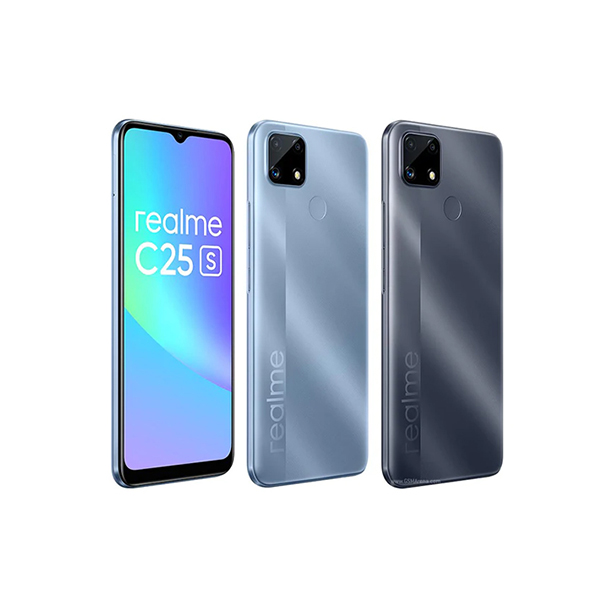
Conclusion
The Realme C25 is a budget-friendly smartphone that excels in battery life and offers a reliable design for everyday use. While it’s not the most powerful or feature-rich device, it strikes a good balance between affordability and functionality. Its camera performance is adequate for casual photography, and its solid build ensures durability. Overall, the Realme C25 is a good option for users seeking a dependable smartphone on a budget, especially those who prioritize battery life and durability over performance and display quality.
Review
Disclaimer Note
All prices in Pakistan is updated daily from the price list provided by local shops and dealers but we can not guarantee that the information / price on this page is 100% correct (Human error is possible), always visit your local shop for exact cell phone cost & rate.
